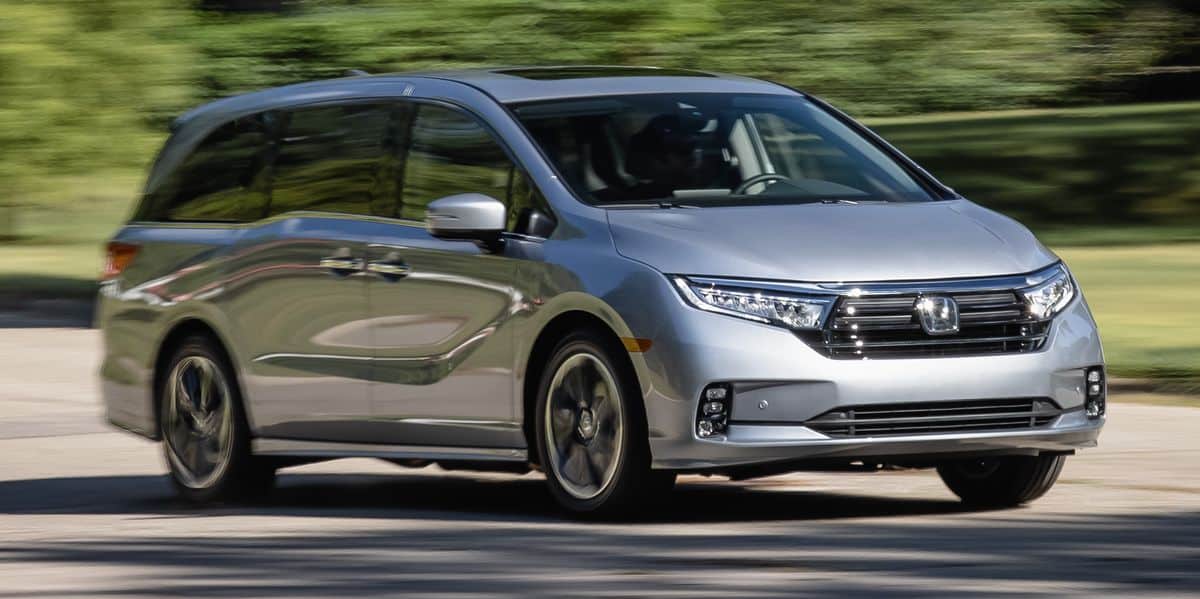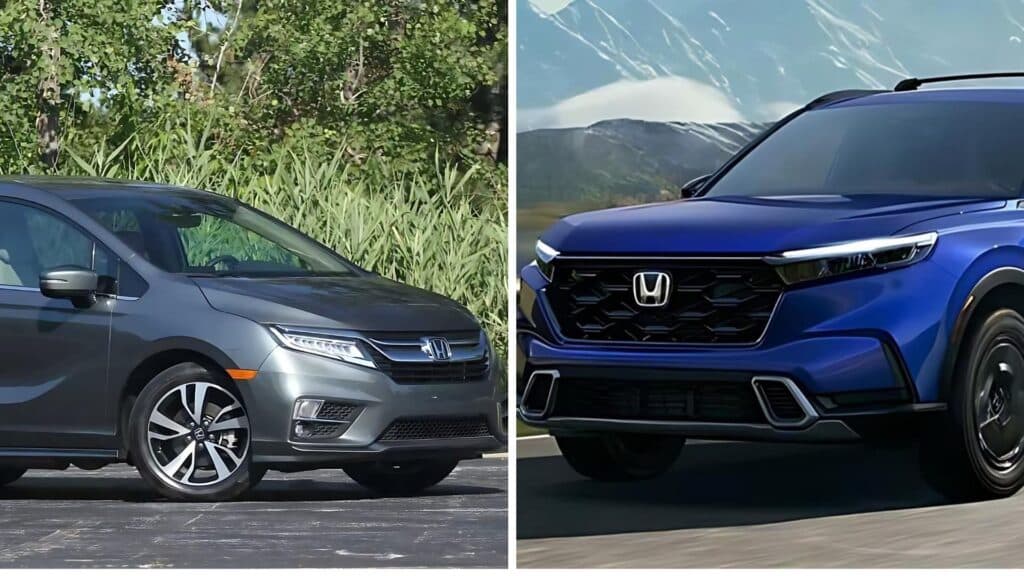Searching for a vehicle with ample seating?
Selecting between a minivan and an SUV can be confusing, especially when considering third-row seating options.
You want a comfortable ride for your family, but navigating the differences can feel like a maze.
Worry not!
We’ve decoded the mystery, unveiling the strengths and weaknesses of Honda’s minivans and SUVs with third-row seating.
Discover which option excels in passenger space, cargo capacity, and versatility.
Prepare to make an informed decision that perfectly aligns with your family’s needs.
Honda Minivans: The Honda Odyssey

1. Comfort and Accessibility of 3rd Row Seating
- The Odyssey’s third-row seating is designed for comfort and accessibility.
- The seats themselves are ergonomically contoured, providing ample legroom and support.
- In contrast, low step-in height and sliding second-row seats ensure easy entry and exit for passengers of all ages.
2. Storage and Space Optimization
- Maximizing interior space is a hallmark of the Odyssey’s design.
- Innovative features like Honda’s magic slide second-row seats and fold-flat third-row seating create a cavernous cargo area when needed.
- This flexibility allows families to adapt the interior to their changing needs.
- Whether carrying luggage, sports equipment, or maximizing passenger capacity.
3. Family-Friendly Features
The Odyssey is packed with features tailored specifically for families.
From integrated entertainment systems with rear-seat displays to multi-zone climate control and advanced safety technologies like Honda Sensing,
every aspect of the minivan is designed to ensure a safe, comfortable, and enjoyable journey for parents and children alike.
Honda SUVs: The Honda Pilot

1. Versatility and Comfort of 3rd Row Seating
The Pilot’s third-row seating offers a remarkable blend of versatility and comfort.
The third row is no mere afterthought. With ample legroom and headroom, it can comfortably accommodate adults.
Furthermore, easy access is ensured through sliding second-row seats, making ingress and egress a breeze.
2. Performance and Towing Capacity
While prioritizing passenger comfort, the Pilot doesn’t skimp on performance.
Robust engine options and impressive towing capabilities make this SUV equally at home on daily commutes or adventurous weekend getaways with trailers or recreational vehicles in tow.
3. All-Terrain Adaptability
The Pilot’s capabilities extend beyond the pavement thanks to its all-terrain adaptability.
Available all-wheel-drive (AWD) systems, terrain management modes, and increased ground clearance ensure that families can confidently explore the great outdoors, regardless of the terrain they encounter.
Honda Minivans vs. SUVs: Comparative Analysis of 3rd Row Seating
| Specification | Honda Odyssey | Honda Pilot |
|---|---|---|
| Engine Power | 280 horsepower | 285 horsepower |
| Fuel Efficiency | City: 19 MPG, Highway: 28 MPG | City: 19 MPG, Highway: 27 MPG |
| Combined Fuel Efficiency | 10.6 L/100km | 11.0 L/100km |
| Interior Space | More front headroom, front shoulder room, rear leg room, and cargo space | More front leg room, rear headroom, and rear shoulder room |
| Tech Features | Advanced infotainment system, safety features like Honda Sensing, multi-zone climate control, rear entertainment system | Similar tech features as Odyssey, with additions suited for off-road capabilities (in higher trims) |
| Starting Price (New) | $39,898 – $51,799 | $42,961 – $54,307 |
| Starting Price (Used) | $34,626 – $50,550 | $23,532 – $53,261 |
| Quality Rating | 9.0/10 | 8.8/10 |
| Reliability Rating | 8.7/10 | 9.1/10 |
| Safety Rating | 5 out of 5 Stars | 5 out of 5 Stars |
- Comfort and interior space are paramount considerations for family vehicles.
- Minivans have traditionally been hailed for their spacious interiors and flexibility, while SUVs offer a unique blend of space and a more rugged, adventurous appeal.
Direct Comparison
Comparing Honda’s minivan offering, the Odyssey, with its popular SUV, the Pilot reveals distinct differences in seating capacity and overall roominess.
The Odyssey boasts impressive legroom in all three rows, and sliding second-row seats make access to the third row easy.
Additionally, the minivan’s seating materials and ergonomics prioritize long-distance comfort.
Conversely, while offering ample space for most families, the Pilot may feel slightly more confined in the third row, especially for adult passengers.
Design Impact
Design elements are crucial in shaping the overall comfort and space equation.
For instance, the Odyssey’s sliding doors facilitate easier entry and exit, while its low step-in height adds convenience.
The minivan’s boxy shape also contributes to a more open and airy interior, with larger windows and a higher ceiling contributing to spaciousness.
In contrast, the Pilot’s traditional doors and sloping roofline can make ingress and egress more challenging, especially in tight spaces.
However, regarding cargo capacity with all seats occupied, SUVs like the Pilot often have the edge over minivans.
Performance and Utility
Choosing between an SUV and a minivan often involves weighing performance and utility against comfort and space.
SUVs are generally expected to offer greater off-road capability and towing capacity, while minivans prioritize fuel efficiency and maneuverability in urban environments.
Performance Details
Honda’s minivan and SUV offerings exhibit distinct performance characteristics.
The Odyssey, powered by a V6 engine, delivers respectable acceleration and a smooth driving experience. However, its primary focus is on fuel efficiency, and it has impressive city and highway ratings.
In contrast, the Pilot’s available engine options, including a potent V6, prioritize power and towing capability over outright efficiency, although its fuel economy remains competitive for the SUV segment.
Additionally, the Pilot’s higher ride height and available all-wheel-drive system enhance handling and stability, particularly in adverse weather conditions.
Utility and Lifestyle Suitability
Urban families may find the Odyssey’s compact footprint and agile handling better suited for navigating crowded city streets and tight parking spaces.
Its impressive fuel economy makes it a cost-effective choice for daily commutes and short trips.
Conversely, the Pilot’s robust towing capabilities and available all-wheel-drive system make it an ideal companion for adventurous families who frequently embark on rural getaways or outdoor excursions.
Its higher ground clearance and off-road prowess provide added peace of mind when venturing off the beaten path.
Vehicle Performance
Minivans excel in urban environments due to their compact footprint, superior maneuverability, and impressive fuel efficiency. They are ideal for city-dwelling families or those requiring frequent short trips.
In contrast, SUVs excel in rural settings or for families that frequently engage in outdoor activities, courtesy of their robust performance, higher ground clearance, and impressive towing capabilities.
Comfort and Space Utilization
Minivans offer unparalleled interior space utilization, rendering them excellent choices for larger families or those requiring significant cargo capacity without sacrificing seating flexibility.
While SUVs provide more versatile passenger-to-cargo conversion options, they typically offer less space efficiency than minivans.
Safety Features and Accessibility
Both vehicle types prioritize advanced safety features, but minivans often have the edge regarding accessibility, with sliding doors that greatly benefit families with young children or elderly members.
Family Size Considerations
Compact SUVs might suffice for smaller families or those without a regular need for extensive cargo space.
However, larger families or those who frequently transport multiple passengers may prefer the spacious third-row seating and easy access offered by minivans.
Lifestyle and Transportation Needs
An SUV is recommended if towing capacity or off-road capability is a priority.
Conversely, a minivan might be better for those prioritizing cost-effectiveness and fuel efficiency, particularly for urban or highway driving.
Budget and Long-Term Use
Each vehicle type’s upfront purchase price and long-term economic implications must be considered.
Factors such as fuel consumption, maintenance costs, and resale value should be carefully evaluated to make an informed decision that aligns with your budget and long-term plans.
The Rise of 3rd Row Seating in Family Vehicles
(A collage or split image showing a Honda minivan (Odyssey) and a Honda SUV (Pilot) with the third-row seating prominently displayed.)
Family vehicles have evolved from traditional sedans to more versatile options catering to the needs of modern families.
Among these adaptations, third-row seating has become an increasingly sought-after feature, providing additional space and flexibility for transporting larger groups.
Historical Context
The demand for roomier family vehicles prompted automotive designers to rethink interior layouts. As families grew, the need for extra seating arose, leading to the development of third-row options.
Key models like the Chevrolet Suburban and Ford Expedition paved the way for this trend, offering ample passenger and cargo capacity.
Current Trends
Today, preferences lean heavily towards SUVs and minivans, reflecting the desire for spacious interiors and flexible seating configurations.
Market analyses and sales data highlight the steady growth of these vehicle types.
These vehicles cater to the evolving needs of modern families seeking versatility and comfort.
Market Dynamics Of Honda’s 3rd Row Seatings
In the current automotive landscape, minivans and SUVs occupy distinct positions, each with its strengths and perceived advantages.
Marketing strategies often emphasize the practical aspects of minivans, while SUVs are portrayed as stylish and capable alternatives.
1. Statistical Insights
- According to industry reports, SUVs have gained significant market share in recent years, outpacing minivan sales.
- However, minivans still maintain a loyal following, especially among larger families seeking maximum interior space.
2. Consumer Preferences
| Factor | Honda Odyssey | Honda Pilot |
|---|---|---|
| Fuel Efficiency | City: 19 MPG, Highway: 28 MPG | City: 19 MPG, Highway: 27 MPG |
| Combined Fuel Efficiency | 10.6 L/100km | 11.0 L/100km |
| Horsepower | 280 HP | 285 HP |
| Price (Used) | $34,626 – $50,550 | $23,532 – $53,261 |
| Price (New) | $39,898 – $51,799 | $42,961 – $54,307 |
| Interior Volume | More front headroom, front shoulder room, rear leg room, and cargo space | More front leg room, rear headroom, and rear shoulder room |
| Quality Rating | 9.0 out of 10 | 8.8 out of 10 |
| Reliability Rating | 8.7 out of 10 | 9.1 out of 10 |
| Safety Rating | 5 out of 5 Stars | 5 out of 5 Stars |
When choosing between minivans and SUVs, consumers consider vehicle size, fuel efficiency, safety features, and cargo capacity.
Brand loyalty and style preferences also play a role, with SUVs often perceived as more stylish and rugged.
Typical buyer profiles and consumer surveys can provide valuable insights into these decision-making processes.
Closing Thoughts
In the ever-evolving landscape of family transportation, choosing between a Honda minivan and an SUV should seamlessly align with your unique needs and lifestyle.
Minivans excel in urban environments, offering unparalleled space utilization and easy accessibility.
SUVs cater to those seeking off-road capability and robust towing performance.
Ultimately, the right choice will meet your immediate needs and adapt to your family’s evolving circumstances, ensuring a comfortable and convenient journey for years to come.
As you embark on this pivotal decision, we invite you to explore our comprehensive Honda model comparisons.
This will lead you to in-depth analyses, consumer insights, and expert guidance, enabling you to make an informed choice tailored to your family’s needs.

